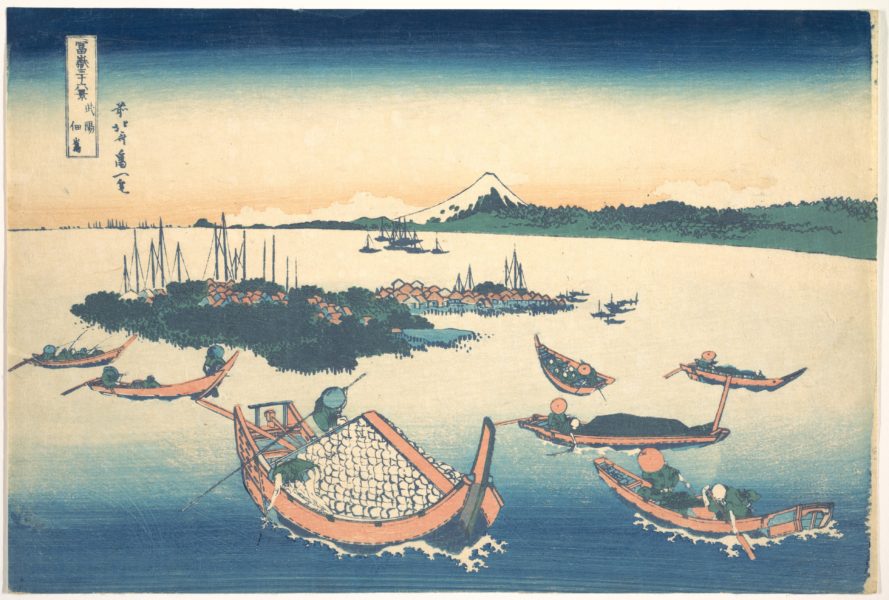In the foregoing parts we have been investigating four series or groups of prints, two of them comprised of aizurie prints exclusively and two other groups with only a part printed as aizurie. In these four groups, we found three different phrasings of Hokusai’s signature, as follows: Hokusai aratame Iitsu (Hokusai changing his name to Iitsu 北斎改為一) on ten prints of the series of Thirty-six Views of Mount Fuji and on all of the so far identified nine envelopes from the series titled A Hundred Views of the Eastern Capital. Then there is the signature Saki no Hokusai (the former Hokusai 前の北斎) on all of the prints in blue from an untitled series in the koban format, and on two (of three?) prints from the untitled series in the tanzakuban format. And lastly the signature Saki no Hokusai Iitsu (Iitsu, the former Hokusai 前の北斎為一) to be found on ten aizurie and twenty-six full colour prints of the Thirty-six Views of Mount Fuji series, as well as on the three aizurie and on another twelve full colour prints in the group of tanzaku prints.

Courtesy Metropolitan Museum of Art, New York
If we then try to bring some order in these findings, we must agree that a signature stating that ‘Hokusai is changing his name to Iitsu’ (Hokusai aratame Iitsu), obviously predates signatures such as ‘the former Hokusai’ (saki no Hokusai) and ‘Iitsu, the former Hokusai’ (saki no Hokusai Iitsu). We are then fortunate to have a date for the use of the signature of the ‘former Hokusai’ on one of the ten koban aizurie prints, in the form of a seal reading ‘old man of 72 years’ (nanajūni-ō), Hokusai’s age corresponding to the year 1831. It is then tempting to also date the two tanzaku prints with the same signature to the same year 1831.
As for works bearing the signature ‘Iitsu, the former Hokusai,’ we have at least the indication that the ten aizurie prints in the Fuji series were being announced as ‘single sheet prints in blues, each featuring one view and to be issued one after the other’ in the I/1831 announcement issued by the publisher Nishimuraya Yohachi. We may thus safely assume that at least the ten aizurie prints in that series can be dated to 1831. And the seal on one of the aizurie prints indicating Hokusai’s age to be 72 years, mentioned above, just confirms that aizurie printing was being practiced in 1831. This date can thus also safely be given to the three aizurie tanzaku prints signed ‘Iitsu, the former Hokusai’ as well as to the remaining twelve full colour prints in that group which were most likely published in the same year. As for the Fuji series, this was, as a much larger enterprise and still something of an experiment at the time when there was no tradition of larger series of landscape prints yet, probably issued over a period of several years.
What then remains is the series of luxury envelopes issued as aizurie and signed ‘Hokusai changing his name to Iitsu,’ and the ten prints in the Fuji series with the same signature. For the moment, we can conclude that these must date from ‘before 1831.’ Yet, we may assume that Nishimuraya waited to announce that the prints in the Fuji series would be printed in tones of blue until he was sufficiently confident that the first group of ten prints sold well. At least well enough to take the risk of issuing the remainder of the series in the newly available but still costly non-fugitive blue pigment, publishing prints was after all a completely commercial enterprise. Most likely, I would say, this means that a first group of Fuji prints had been issued some time in 1830 and needed already to be reprinted several times as demand proved to be lasting.
Just to corroborate or contradict these findings, let us have a look at Hokusai’s signatures around this period: He signed a painting of a seller of New Year’s charms (British Museum Collection) ‘Hokusai Iitsu’ in I/1827; he signed the novel Shinpen Suikogaden Part 2a Hokusai Taito in I/1829 and in the same month, his Chūgi Suikoden ehon was signed Katsushika saki no Hokusai Iitsu – and we must remember that Hokusai often used different signatures for different audiences, and these are a painting, a popular novel, and a picture book respectively. In III/1830, he signed a surimono print of two women gathering salt water by the seaside ‘Hokusai aratame Iitsu,’ or ‘Hokusai changing his name to Iitsu.’
I couldn’t find, so far, any other examples of the signature ‘the former Hokusai,’ but we do see the signature ‘Iitsu, the former Hokusai’ from 1831: it is used in two announcements in I/1831, the one concerning the sequel of the Fuji series of prints, the other one for a novel in eight volumes written by Ryūtei Tanehiko (not yet identified), and again in III/1831 in the 1-volume poetry collection Onna ichidai eigashū, as well as later also, in 1832, 1833 and so on. I am real glad we are here now, and I promise to make a clean and clear chronology soon, to appear in the next part of this series of notes that was concerned with the date of the Great Wave to begin with.